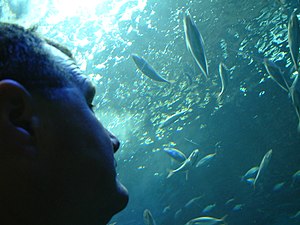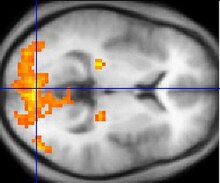Chemistry and consciousness/Is consciousness a chemical process?

Welcome to the Wikiversity discussion group oriented around the question: Is consciousness a chemical process? This first lesson in the "Chemistry and consciousness" learning project introduces the idea that consciousness can be traced to a few special types of chemical processes found in brains.
Introduction
[edit | edit source]
Francis Crick wrote a book called The Astonishing Hypothesis in which he said that "a person's mental activities are entirely due to the behavior of nerve cells, glial cells, and the atoms, ions, and molecules that make them up and influence them." Crick acknowledged that this "astonishing hypothesis" strikes many people as an absurd idea. In contrast to the view point of many non-biologists, Crick explains why so many working biologists do not find the idea particularly astonishing but rather the simplest and most likely solution to what has been the long standing mystery of consciousness.
If the Astonishing Hypothesis is correct, then we should be able to list the biochemical processes that generate consciousness. If we do a thorough job, then when we are done, there should be no more mystery about the origin of consciousness and no more need to imagine that some non-material vitalistic force or soul is needed in order to try to explain consciousness. Possibly, if we can fully explain the biological mechanism of consciousness then it may become possible to transfer that knowledge to the task of creating man-made conscious machines. What is the biochemical basis of consciousness?
Suggested reading
[edit | edit source]- The Astonishing Hypothesis: The Scientific Search For The Soul by Francis Crick (Scribner reprint edition, 1995) ISBN 0-684-80158-2
Discussion
[edit | edit source]- Why did Crick decide to emphasize visual awareness in his work on consciousness?
Q. In this regard, Do animals have consciousness to the level & complexity us humans experience the world & are "aware" about our actions? Why could homo sapiens expand colonies and construct a society & have made such advancements throughout our history of existence? How do we correlate the labyrinth of biochemical processes going on to a conscious decision taken to drink water? What makes the state of consciousness for human beings different from millions of other of species on this planet? (where does the concept of soul arise in this discussion? Is it a result of the complex mosaic biochemical signals generated which is infinitesimally different for everyone because of individual genetic makeup? Or is it much more than biochemical?)
Consciousness and the brain
[edit | edit source]
In order to make a start on the biology of consciousness, it is important to zero in on its physical locus. When Descartes suggested that the pineal gland might be the center of human consciousness, it was still possible to imagine that the brain was some sort of hydraulic actuating system for sending cerbrospinal fluid through tubes and forcing parts of the body in motion. We now know, however, that the pineal gland functions in the endocrine system. Sometimes, due to growth of tumors, the pineal gland is surgically removed (pinealectomy). This does not cause loss of consciousness.[1] The endocrine function of the pineal gland can be replaced by providing melatonin as a supplement.
Consciousness is no longer thought to be a single thing that might be channeled into the brain by way of a tiny organ, like the pineal gland. Large parts of the human brain participate in the generation of many different types of conscious experiences. Some of the most well-studied parts of the brain with respect to their roles in consciousness are parts of the visual cortex. Damage to small parts of the visual cortex can selectively destroy conscious awareness of color, motion or even selectively remove one's ability to be consciously aware of faces as the unified wholes that we normally take for granted as social primates. Since the locus of consciousness is brain tissue, we can turn our attention to a detailed analysis of the biochemical processes of brain cells.
Additional reading
[edit | edit source]- Understanding consciousness by Giovanni Frazzetto. Short replacement for Crick's The Astonishing Hypothesis.
- Naturalizing consciousness: A theoretical framework by Gerald M. Edelman. A more intense (yet still short) look at how biologists view consciousness.
Discussion
[edit | edit source]- What tools can be used to alter brain activity and consciousness?
Distributed brain function
[edit | edit source]Most chemical processes in the brain are not unique to the brain. What brain processes are unique and important for consciousness?
As discussed above, brain regions that are involved in generating conscious experiences are widely distributed in the human brain. In "Naturalizing consciousness: A theoretical framework" (see § Additional reading, above), Gerald Edelman lists some key features of consciousness, including "the contrast between the diversity and changeability of conscious states and the unitary appearance to the conscious individual of each conscious state." Multiple regions of the brain are specialized for generating particular conscious experiences, but we normally have a "stream of consciousness" that allows us to focus our attention on a limited set of conscious experiences at any one time. Consciousness, as normally experienced, relies on a mechanism for coordinating the activity of a complex and widely distributed network of neural activity. In a rich environment, the brain's subsystems are constantly generating a multitude of potential experiences, but in some sense we have a limited "bandwidth" that restricts to what we can actually pay close attention at any instant.

An example of how the brain can shift between competing experiences is provided by ambiguous visual stimuli such as the Necker cube. There is clear survival value in our brains being able to generate a wide variety of conscious experiences, but to avoid being distracted by that which is unimportant, we also need ways to select a limited subset of what our brains can "show" us for close attention and control of our behavior. The key brain processes that coordinate the distributed information processing of the brain are electrical signals in the form of the action potential and chemical signals carried between neurons. The biochemical basis of action potentials and neurotransmission are discussed in more detail in the next lesson.
The brain is not like a printed circuit board nor an integrated circuit. We cannot have the ordered neural activity of consciousness unless complex neuronal circuits can be established during embryogenesis and later brain development. The biochemical basis of brain development is also discussed in detail in the next lesson.
Discussion
[edit | edit source]- How can a single visual stimulus result in conscious awareness of two different visual perceptions?
See also
[edit | edit source]- Chemistry and consciousness - main page for the Chemistry and consciousness learning project
- Neurochemistry - next page in the series;
References
[edit | edit source]- ↑ Disappearance of plasma melatonin after removal of a neoplastic pineal gland by E. A. Neuwelt and A. J. Lewy in The New England journal of medicine (1983) Volume 308, pages 1132-1135.
